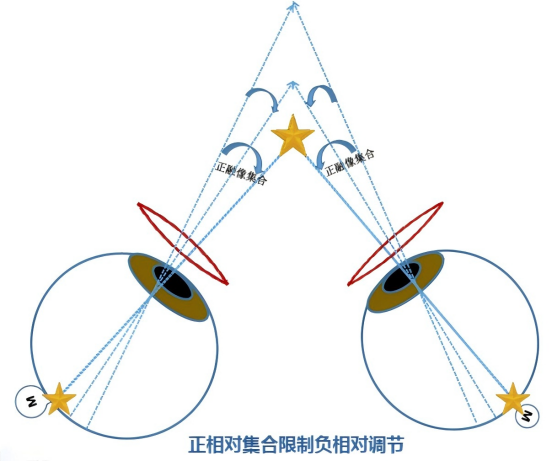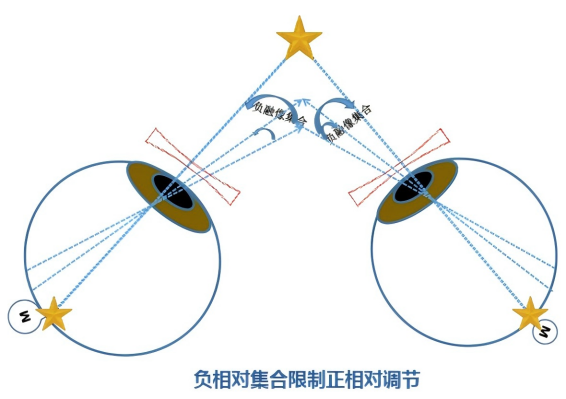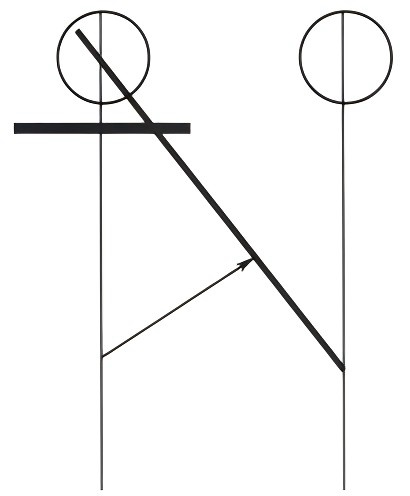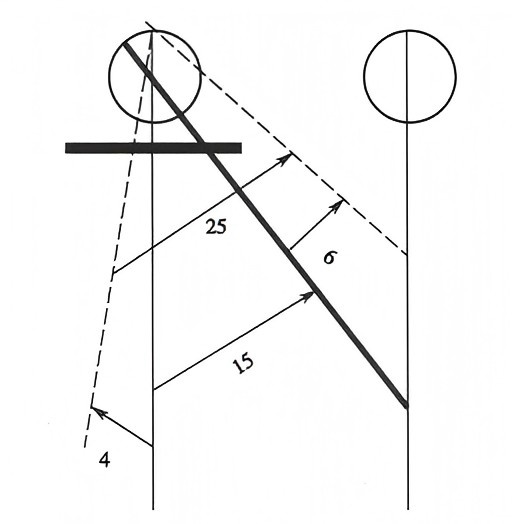
1. Interaction Between Accommodation and Convergence

The neural impulses for accommodation are obtained through a negative feedback mechanism, which refers to the process of reducing the stimulus that triggers this response through dynamic reactions. For example, when shifting focus from distant to near targets, the initial image on the retina is out of focus, resulting in a blurred spot. Blurriness is considered a major factor in initiating accommodation (Health, 1956). The neural impulses generated in response to the blurriness act on the ciliary muscle, causing the lens to become more convex, thereby reducing the defocus and the size of the blurred spot.
-
If the initial accommodation does not make the image clear enough, this accommodation response will continue to occur until the retinal blur is minimized; this feedback loop is called the accommodation negative feedback loop.
The neural impulses for convergence are also obtained through a negative feedback mechanism. For instance, the cross-retinal disparity stimulates the generation of neural impulses for convergence, causing the eyes to converge. Increased convergence reduces the cross-retinal disparity; if the initial convergence does not align the visual axes accurately, the retinal convergence response will continue until the retinal disparity is minimized; this feedback loop is called the convergence negative feedback loop.
2. Accommodation Demand and Convergence Demand

Objects at a specific distance induce the eyes to accommodate to see them clearly; the amount of accommodation required is called accommodation demand, while the amount of convergence required for binocular single vision is called convergence demand. Accommodation demand is the reciprocal of the distance from the eye’s principal point to the object (in meters), but clinically it is measured from the spectacle plane (12mm from the front vertex of the eye), with units in diopters (D).
Convergence demand is the reciprocal of the distance from the line connecting the centers of the two eyes (the baseline) to the object (in meters), with units in meter angles (Ma), which is independent of the interpupillary distance. Convergence demand can also be expressed in prism diopters (△), calculated as interpupillary distance (cm) / object distance (m), which is dependent on the interpupillary distance. For the same distance object, a larger interpupillary distance results in a greater convergence demand than a smaller one, making prism diopters a more reasonable measure.

Due to the difference of2.7cm between the termination points of accommodation demand and convergence demand (15mm from the center of the eye to the front surface of the cornea, and 12mm from the front surface of the cornea to the spectacle plane), the two are not linearly related, especially when viewing nearby objects. The table below shows the magnitudes of accommodation demand and convergence demand at different fixation distances, with convergence demand expressed in prism diopters (△).

The effect of spectacles on accommodation demand and convergence demand: due to the vertex distance between the spectacle plane and the principal point, wearing distance glasses changes the accommodation demand when viewing nearby objects, reducing the accommodation demand for myopes and increasing it for hyperopes. When viewing nearby objects, the visual axes of both eyes converge inward through the eccentricity of the glasses, which also alters the convergence demand; myopes experience a decrease, while hyperopes experience an increase. Therefore, when myopes switch from glasses to contact lenses, they may encounter binocular vision issues.
3. The Relationship Between Relative Accommodation and Relative Convergence

1. Relative accommodation: the accommodation that can be independently utilized while keeping convergence fixed is called relative accommodation. For example:
-
A normal eye viewing an object at 33cm applies 3D of accommodation and 3Ma of convergence; if a negative lens is added in front of both eyes and the power is gradually increased, when it reaches -3.0D, the target becomes blurred; the maximum negative lens power that can still be seen clearly is 3.0D, which is its positive relative accommodation.
-
When a positive lens is added in front of the eyes, if it reaches +2.0D, the target becomes blurred but can still be seen clearly; the maximum positive lens power that can still be seen clearly is 2.0D, which is its negative relative accommodation.
The significance is that if positive relative accommodation is less than negative relative accommodation, it is difficult to maintain prolonged reading or near work; only a larger positive relative accommodation can allow for sustained near vision without causing visual fatigue.
2. Relative convergence: the convergence that can occur independently while keeping accommodation fixed is called relative convergence. The increase in convergence is called positive relative convergence, while the relaxation of convergence is called negative relative convergence. For example:
-
A normal eye viewing an object at 33cm, with accommodation fixed, adds a BO prism until the target becomes blurred without diplopia; the highest prism degree (i.e., BO) at which diplopia does not occur is the positive relative convergence value, indicating the additional convergence power that can still be achieved;
-
When a BI prism is added in front of the eyes, the highest prism degree (i.e., BI) at which diplopia does not occur is the negative relative convergence value, indicating the relaxation of the divergence power that can still be achieved.
The significance is that during near vision, it is essential to maintain a surplus of positive relative convergence, i.e., convergence power, to ensure comfort and endurance.
3. Accommodation and convergence influence each other; accommodation drives convergence, and convergence can also drive accommodation:
(1) Positive relative convergence (PRC) affects negative relative accommodation (NRA)

(2) Negative relative convergence (NRC) affects positive relative accommodation (PRA)

-
Positive relative accommodation (PRA) is below normal: difficulty in relaxing accommodation or small positive relative convergence (PRC)
-
Negative relative accommodation (NRA) is below normal: insufficient accommodation or small negative relative convergence (NRC)
-
Positive relative accommodation (PRA) = negative relative convergence (NRC) / (AC/A)
-
Negative relative accommodation (NRA) = positive relative convergence (PRC) / (AC/A)
(3) The relationship between accommodation, convergence, and pupil constriction forms a triad. Its advantage is to increase the efficiency and synchrony of neural control. The pathways of their interconnections are accommodative convergence (AC) and convergence accommodation (CA).

-
AC/A: The ratio of accommodative convergence to the accommodation that triggers it, indicating the amount of convergence change per 1D of accommodation;
-
CA/C: The ratio of convergence accommodation (the change in accommodation triggered by convergence) to convergence, indicating the amount of accommodation change (D) per 1 prism diopter of convergence.
The average AC/A ratio is 4/1, slightly increasing with age, and shows an exponential rise in the pre-presbyopic stage. The average CA/C ratio is 1/12, peaking at age 10, and decreases linearly with age, dropping to 0 after age 40. Clinically, the AC/A ratio is an important basis for diagnosing and managing binocular vision anomalies.
4. AC/A

(1) Overview

-
A stands for accommodation
-
C stands for convergence
-
AC stands for accommodative convergence
-
AC/A value represents the ratio of accommodative convergence to accommodation
-
Normal value: 3~5 or 2~6.
(2) Classification and Measurement

1. Stimulus AC/A ratio and Response AC/A ratio
-
Stimulus AC/A: accommodative convergence amount / accommodation stimulus
-
Response AC/A: accommodative convergence amount / accommodation response
Clinically, the sum of accommodation demand and the test lens power is used as the accommodation stimulus, and the measured accommodative convergence amount is compared to obtain the stimulus AC/A ratio. However, the actual accommodation response amount may not equal the accommodation stimulus amount, usually lagging by +0.25 to +0.50D. The accommodation response amount can be determined by objective computer refractors or dynamic retinoscopy, and the measured accommodative convergence amount is compared to obtain the response AC/A ratio. This is necessary for research purposes due to its accuracy, but in clinical practice, for convenience, only the stimulus AC/A ratio is used.
2. Calculated AC/A ratio and Gradient AC/A ratio
(1) Calculated AC/A ratio
Accommodative convergence can be represented by the change in latent strabismus from distance fixation to near fixation. If we know the latent strabismus at distance and near (under the same refractive correction), we can calculate the patient’s AC/A ratio. The calculated AC/A can be obtained in two ways:
1) “Big N” method to calculate AC/A (as shown below)

Example 1: As shown below, at distance, there is 4△ exo, and at near, there is 6△ eso. When shifting from distance to near fixation, he accommodates 2.5D, and the convergence demand is 15△, thus the total convergence amount is 4 + 15 + 6 = 25△, so the subject’s AC/A = 25 / 2.5 = 10 / 1.

Example 2: As shown below, at distance, there is 4△ eso, and at near, there is 2△ exo. When shifting from distance to near fixation, he accommodates 2.5D, and the convergence demand is 15△, thus the total convergence amount is 15 – (4 + 2) = 9, and the subject’s AC/A = 9 / 2.5 = 3.6 / 1.

2) Two formula calculation method
All measurements must be taken on the basis of fully correcting refractive errors, using the Maddox rod or Von Graefe method to detect the latent strabismus values at distance and near.
① AC/A = (near convergence demand – distance latent strabismus + near latent strabismus) / near accommodation demand
-
Convergence demand = near distance accommodation amount (in D) × interpupillary distance (in cm)
-
Near distance accommodation amount: expressed in D, D = 1/d, where d is the fixation distance in meters
-
Exo strabismus is negative; eso strabismus is positive
-
Distance latent strabismus: DLP; near latent strabismus: NLP
Example: The patient’s interpupillary distance is 6.0cm, convergence demand = 2.5D × 6.0 = 15△ (ignoring the distance from the spectacle plane to the center of rotation), DLP is 4△ exo, NLP is 6△ eso (40cm), what is the AC/A?
AC/A = [15 – (-4) + 6] / 2.5 = 25 / 2.5 = 10 / 1
② AC/A = interpupillary distance + near measurement distance × (near latent strabismus – distance latent strabismus)
-
Interpupillary distance is in cm, near measurement distance is in m
-
Interpupillary distance: PD; distance latent strabismus: DLP; near latent strabismus: NLP
-
Exo strabismus is negative; eso strabismus is positive
Example: PD = 6.0cm, DLP = 2△ exo, NLP = 10△ exo, AC/A = 6 + 0.4[-10 – (-2)] = 2.8 / 1
(2) Gradient AC/A ratio

Conduct two near distance Von Graefe measurements: the first using the corrective prescription, then adding +1.00D (to relax accommodation) or -1.00D (to stimulate accommodation) to the prescription and measuring again, then comparing the two latent strabismus amounts. Adding +1.00D or -1.00D changes the accommodation stimulus by one unit, which will cause a change in accommodative convergence, and the change in latent strabismus depends on the subject’s AC/A ratio; if the subject’s AC/A is 4, then when we increase the prescription by +1.00D, the near latent strabismus will change by 4 prism diopters.
-
Positive lenses reduce accommodation, thus reducing accommodative convergence; positive lenses increase exo strabismus and decrease eso strabismus;
-
Negative lenses increase accommodation, thus increasing accommodative convergence; negative lenses decrease exo strabismus and increase eso strabismus.
The calculation formula is:
AC/A = [near latent strabismus – (near latent strabismus with +1.00D)] / (+1.00D)
-
Exo strabismus is negative; eso strabismus is positive
-
Record: prism diopters and strabismus type, e.g., NLP: 4△ eso, +1.00D 3△ exo, AC/A: 7/1
Example 1: Near strabismus is 3△ exo; with -1.00D, near strabismus is 2△ eso, then
Gradient AC/A = (-3 + 2) / -1 = -5 / -1 = 5 / 1
Example 2: Near strabismus is 4△ exo; with +1.00D, near strabismus is 8△ exo, then
Gradient AC/A = [-4 – (-8)] / 1 = 4 / 1
Example 3: Near strabismus is 3△ eso; with +1.00D, near strabismus is 5△ exo, then
Gradient AC/A = [3 – (-5)] / 1 = 8 / 1
5. Comparison of Gradient Method and Calculation Method

1. Advantages and Disadvantages of Calculated AC/A Value:

-
Advantages: The AC/A ratio and the amount of convergence change caused by accommodation are linearly related; the ratio of convergence values measured under different accommodations is constant; accommodation occurs without human interference, with minimal other factors affecting it, representing a natural visual state; the testing method is convenient, with no additional steps required.
-
Disadvantages: The calculated AC/A ratio has distance and near differences when measuring latent strabismus; when measuring near, it is influenced by near perceptual convergence, which increases the value, while the gradient AC/A ratio is measured at near, where near perceptual convergence cancels out, thus the calculated AC/A ratio is generally larger than the gradient AC/A ratio under normal conditions.
▶ Based on the differences in the two testing methods, the ratio of near perceptual convergence to accommodation can be measured. The normal value in the population is 0.75△/D ± 0.5△/D.
2. Advantages and Disadvantages of Gradient AC/A Value:

-
Advantages: Both measurements are taken at the same distance, eliminating the influence of near perceptual convergence; more practical, providing more information about the ease of triggering and relaxing; no calculations are needed, making it easy to obtain AC/A ratio results.
-
Disadvantages: Gradient AC/A is influenced by many factors, such as mental state, brightness, accommodation issues, etc.; when the subject has accommodation problems, the data obtained may be unreliable; it adds an additional testing process, increasing the time for visual examination.
In clinical practice, the CA/C ratio has not been widely applied; during measurement, a non-blurry visual target Gaussian difference (different of Gaussian, DOG) card or pinhole should be used to eliminate the effect of blurriness on accommodation stimulation, allowing the subject to view the target at four different distances, using retinoscopy to determine the amount of accommodation; the stimulus CA/C ratio and response CA/C ratio are essentially the same, and there is no need to differentiate.
6. Significance of AC/A

1. It is of great significance for the diagnosis and treatment of strabismus, especially for patients with accommodative esotropia;
2. It provides guidance for the treatment of strabismus;
3. It offers guidance for refractive correction.
References:
1. Binocular Vision Science / Wang Guangji, ed. — 3rd ed. — Beijing: People’s Health Publishing House, 2018
2. Theories and Methods of Optometry / Qu Jia, ed. — 3rd ed. — Beijing: People’s Health Publishing House, 2018
Related Reading
A comprehensive overview of accommodation: mechanisms, physiology, definitions, classifications, and related concepts
A comprehensive overview of convergence: definitions, classifications, and related concepts
A complete analysis of the Maddox rod for measuring eye position: horizontal, vertical, rotational strabismus, and unequal images
A complete analysis of the Von Graefe method for measuring eye position: principles, types, processes, and common issues
Some images are sourced from the internet and are for educational purposes only; please delete if infringing.

Disclaimer: This article is for academic exchange among healthcare professionals only and does not represent the views of this platform. This information should not be considered a substitute for professional medical guidance and should not be regarded as diagnostic or treatment advice. The platform and the author bear no responsibility if this information is used for purposes other than informational.